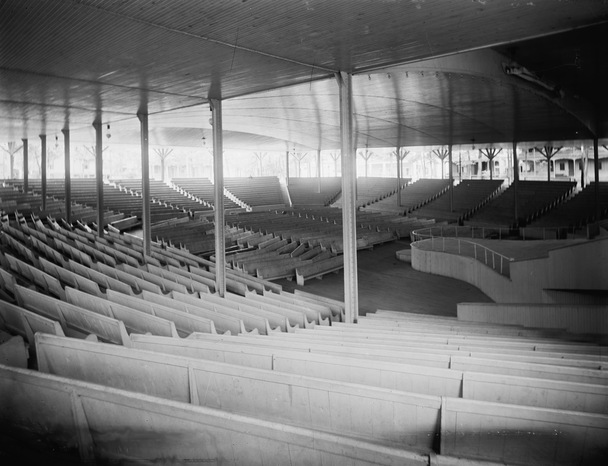
Seen here shortly after its construction, ca. 1895, the Chautauqua Amphitheater has played host to ideas, personalities and performers that have shaped and altered American history.
Library of Congress
Since we featured Brian Berg’s evocative story, “Is a Replica True to Chautauqua’s Mission?” as the Winter 2015 installment of our “Another Look” feature, the storied structure has remained a preservation hot button. It therefore seemed appropriate to include a brief update on some important developments in the evolving story of “the Amp,” and to reemphasize the importance of this treasure of Western New York—and American—history.
As Mr. Berg deftly outlined in his previous piece, the Chautauqua Institution’s historic amphitheater is a National Historic Landmark that has played a significant role in the development and dissemination of the “Chautauqua Idea.” Over its 122-year history, it has also provided a platform for personalities and performers from The Roosevelts, Susan B. Anthony and William Jennings Bryan to Lionel Hampton and Marian Anderson.
The Chautauqua Institution’s plan to demolish the Amp for a new building has met with outcries and resistance from a variety of camps. In January, as our winter issue was going to press, the National Trust for Historic Preservation added the amphitheater to its evolving portfolio of National Treasures - a collection of threatened historic buildings, neighborhoods, communities and landscapes across the country, to which the National Trust is committed to finding a long-term preservation solution.
More recently, the National Trust has upgraded its public concern over this historic structure. On June 23, it announced that the Chautauqua Amphitheater has been named to its 2015 list of America’s 11 Most Endangered Historic Places. In order for a place or structure to be named to the list, it must meet three criteria: significance, urgency—in that there must exist a need for immediate action to stop a threat—and potential solutions, in that options alternative to demolition must be presented. The Amp meets all three of these criteria, and the National Trust hopes that its inclusion on the list will send a strong message to the institution that alternative renovation plans should be considered.
According to National Trust spokesperson, Alicia Leuba, nominations from individuals and groups throughout the country are considered when compiling the annual list. In the case of the Amp, nominations, “came from people all over the country who weren't necessarily connected to one another but all of whom care about the amphitheater." She also added that such a varied outpouring of concern was unusual in her experience.
“The story of the Amp is the story of America’s political, cultural and spiritual identity,” added Stephanie Meeks, president of the National Trust. “Before television, radio and the internet, America had the Amp to communicate and share the news, music and gospel of the day. For well over a hundred years, it has occupied a special place in American culture, and we believe a solution can be found to ensure that it stands for the next 100 years.”
While only time will tell if adding the Amp to the list will be enough to save the structure, there is certainly cause for optimism. Historically, the designation has been a powerful tool for raising awareness and rallying resources to save endangered sites from every region of the country. Since its inception in 1988, America’s 11 Most Endangered Historic Places has identified more than 250 threatened one-of-a-kind historic treasures. Only a handful of sites so listed have subsequently been lost.
Those concerned about the plight of this regional treasure are invited to follow the National Trust on Twitter at @savingplaces and join the conversation using the hashtag #11Most. More information, along with a petition, may also be found at www.savetheamp.org.







